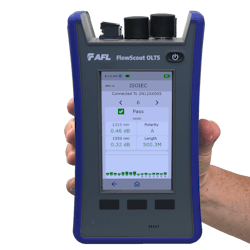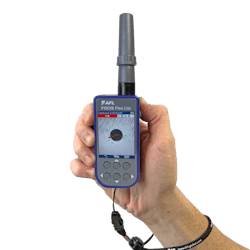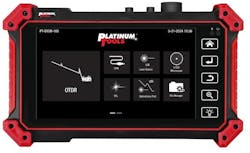Field testing installed fiber-optic circuits is necessary to ensure the links can support their intended applications. The Telecommunications Industry Association’s (TIA) ANSI/TIA-568.3 standard defines Tier 1 and Tier 2 field tests. A Tier 1 test measures loss, length, and polarity. A Tier 2 test performs measurements meant to identify anomalies such as excessive loss or a fiber break.
Tier 1 testing is far more common than Tier 2 testing according to this article from Fluke Networks. To perform a Tier 1 test a technician can use an optical loss test set (OLTS) while a Tier 2 test requires the use of an opitcal time domain reflectometer (OTDR). In this article we’ll be providing information on both Tiers, tests, and products used to help with testing.
Tier 1 and Tier 2 testing
The aforementioned Fluke Networks article explains that sometimes Tier 2 testing is requested due to tight loss budgets and “less room for error” in fiber networks, or a need to learn more about the performance of a link component for troubleshooting reasons. An important note regarding Tier 2 testing is that it “does not replace the total insertion measurements taken during Tier 1 testing.” Tier 1 testing is required prior to Tier 2 testing as the total fiber losses of the link need to be measured. It’s best to think of Tier 2 testing as complementary to Tier 1. Having both will provide a full picture of the fiber installation, however Tier 2 testing cannot be done without Tier 1 testing.
Once a technician has completed Tier 1 testing to determine whether or not the fiber links adhere to the loss budgets specified by TIA and ISO/IEC standards for their application, they connect the OTDR to one end of the link using a launch fiber and fasten a tail fiber to the connector at the end.
Optical Loss Test Set (OLTS)
The OLTS is a device that helps with Tier 1 testing and includes an optical power meter and a light source. It is used for single-ended loss measurements by injecting light from the source and measuring the power at the other end of the fiber. The result provides the total loss (attenuation) across the fiber, including connectors, splices, and the fiber itself. Essentially, this test measures the loss of signal strength over the length of the fiber, making sure that the network meets loss budgets and can deliver signals with little attenuation.
One of AFL’s latest products
The AFL FlowScout MPO OLTS is one of the company’s recently launched testing products. According to Arun Jain, director of product marketing for AFL’s test and measurement business, is the company’s “lead product for hyperscale data centers.”
As its name indicates, the FlowScout MPO OLTS tests multiple fibers in an array-style (MPO) connector. FlowScout MPO tests up to 16 fibers within the MPO simultaneously. The product represents the latest evolution in array-fiber testing—upping the ante from previous-generation test method that was limited to 12 fibers under test simultaneously, and required a separate, automated switch device to test 16 fibers.
Jain describes the product’s efficiency, stating, “It does reduce time by 2/3… These data centers—the Googles and Amazons of the world—they live for one thing only: speed. They need to do everything yesterday, so this is a big deal.”
He goes on to note another key feature of the FlowScout MPO OLTS, “There is still some single fiber testing that is required in these data centers, for various purposes, and single fiber testers from our competition are separate products. So, you would have to buy 2 products, one for MPO testing, one for single fiber testing. We included that single fiber testing—dual LC testing—so you don't have to buy 2 testers.”
Figure 1: AFL FlowScout MPO
Basic, yet important, fiber tests
Fiber-optic connector inspections ensure that fiber connectors are clean and free from defects, which is imperative when optimizing fiber network performance. Although not included in Tier 1 test requirements, fiber inspection is widely regarded as a best practice and critical part of the fiber-link verification process. AFL’s FOCIS Flex Lite fiber inspection probe is equipped with a high-resolution camera to capture images of the fiber-optic connector endface. It is used during the installation and maintenance of fiber-optic networks to verify the cleanliness of fiber connectors before finalizing the installation. The AFL FOCIS Flex Lite helps to ensure high-quality installations by inspecting fiber connectors for contamination or damage.
FOCIS Flex Lite is made for the telecommunications market and is a derivative of a the company’s original FOCIS Flex, which has been in the industry for years. The Lite version is a simpler, cost-reduced option.
Jain comments on the reason AFL developed and introduced the FOCIS Flex Lite: “We built it as a requirement for some telecom customers who buy not in single units or tens of units, but in hundreds, sometimes thousands. So pricing is very important, and they asked us for a specific configuration.” The resulting FOCIS Flex Lite contains some but not all of the original’s functionality, and comes in at a reduced price point.
AFL’s FOCIS Flex Lite simplifies the testing process by making it so that after attaching to the connector, a technician only has to press a single button. It auto focuses on the endface, captures and centers the endface image, analyzes the connector by applying pass/fail rules, and displays the results instantly. It does all this within a few seconds, and if a technician receives a fail, the image indicates what and where the problem is.
Jain adds the FOCIS Flex Lite “is also very ergonomic, about half the size of a smartphone, just a little bit deeper. It is untethered, self-contained, has a screen and a battery that lasts for many hours.” He says it has become popular in part because for many technicians, it delivers all the capabilities they need in an efficient and cost-effective package. It is designed to be used by technicians who may not have gotten or needed any training.
Figure 2: AFL FOCIS Flex Lite
Optical time domain reflectometer (OTDR) testing
The Tier 2 test done in the field uses an OTDR. OTDRs determine the integrity of the entire fiber link, locate faults, and measure fiber length and loss. An OTDR sends pulses of light into the fiber and measures the time it takes for reflections to return. The time and strength of the reflections give information about the fiber's length, attenuation, and locations of faults or damage. OTDRs can find defects in optical fibers, including breaks, bends, and poorly installed splices, in singlemode and multimode fibers.
A multi-purpose product solution
Platinum Tools’ PT-OTDR-100 mini OTDR is a recently launched product that is capable of not only conducting Tier 2 testing with its OTDR functionality, but also has other useful features to conduct tests and help technicians. This product is not only a fiber optic tester, but can also do basic copper cable testing including wiremap. The PT-OTDR-100 mini OTDR has a power meter, visual fault locator, and flashlight all built in.
Platinum Tools product manager Sean Rothermel says of the PT-OTDR-100, “I commonly refer to this unit as kind of a little Swiss army knife cable tester. It checks a lot of boxes for a lot of people. It's not going to be your top-of-the-line super-high-end OTDR product; this is kind of your entry level OTDR tester. However, it has much more than just that OTDR functionality, which sets it apart.”
Rothermel says that users may not “a slight bit of training” when getting started with the mini OTDR, but the manual includes comprehensive information on setup and use. He has delivered training on its use frequently and comments, “It’s extremely easy to use,” pointing out its autotest functionality.
Figure 3: Platinum Tools PT-OTDR 100 mini
Different industries find use in the Platinum Tools’ product
Platinum Tools has a heritage in the security industry, and in more recent years has branched into the telecommunications industry through acquisitions and product development. As many security installers and technicians likewise have broadened their offerings to include telecom work, they have found a familiar brand in Platinum for their test-equipment needs. Rothermel says the PT-OTDR-100 is a good example. “They love this product,” he says, because for installers with significant security backgrounds, fiber testing may be a relatively new experience and the PT-OTDR-100’s combination of simplicity and versatility is “an extremely powerful tool in their hands.”
He adds many service-provider customers use this mini OTDR for field work, which allows them to keep a higher-end OTDR in the lab and away from the perils like damage or theft that can come with field work. “They don’t want to buy five of their highest-end testers, so they buy five of these,” he explains.
Conclusion
Depending on the test required, either an OLTS or an OTDR is typically used within Tier 1 and Tier 2 testing, respectively. However, Tier 2 testing cannot be done without Tier 1 testing first. Thankfully, there are many products on the market, including those mentioned in this article, to make the process of testing simple and fast for technicians.
About the Author
Serena Aburahma
Associate Editor
Serena Aburahma is an editor and writer for CI&M, with several years of experience in writing, editing, and SEO. Serena has pitched and created content for various industries, including technology, video games, insurance, cars, pop culture, and more. She has also produced content for and managed CI&M's various social media accounts and is always looking for fresh and exciting ways to grow and engage with audiences.
Much like the content Serena has written about, her interests vary as well, including writing poetry and stories, meandering in nature, playing video games, traveling, and reading.




